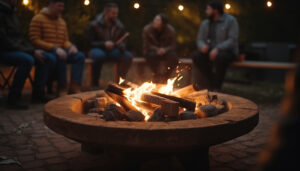A fire pit in the backyard is an excellent way to establish a warm and inviting outdoor area. Whether you’re toasting marshmallows with friends or savoring a peaceful night by the fire, fire pits add warmth and allure to any outdoor space. Nonetheless, with this attractiveness also arrives obligation, including understanding important safety questions like, “How close can a fire pit be to a house?
A frequently asked question by homeowners is, “How close can a fire pit be to a house?” Incorrect setup can create serious dangers, such as fire risks, damage to property, or penalties for failing to comply. This manual will direct you on secure fire pit positioning, typical errors to prevent, and practical safety advice.

Understanding Safe Distances
The General Rule for Fire Pit Placement
The general guideline suggests positioning your fire pit a minimum of 10–25 feet from any home, fence, or flammable structure.
- For Gas Fire Pits: Maintain a minimum of 10 feet from structures. Gas fire pits offer controlled flames, but they still present risks if placed too close.
- For Wood-Burning Fire Pits: A minimum distance of 25 feet is necessary because of open flames and the possibility of sparks and embers flying.
When uncertain, favor prudence. Extending the distance simply enhances the security of your property.
Check Local Fire Codes and Guidelines
Numerous areas have particular rules regarding the location of fire pits to minimize fire risks. Researching and following these guidelines is essential.
- What Your Fire Department Says: Most fire codes mandate a certain minimum distance between your fire pit and any buildings.
- Homeowners Association (HOA) Policies: Some HOAs may have additional rules or restrictions for fire pits.
Tip: Breaking local fire codes results in fines or liability for damages. Contact your local fire department to ensure your fire pit meets regulations.
Consider External Factors
Proper positioning of a fire pit involves more than just how far away it is. Take into account these extra elements to enhance safety:
- Wind Direction: Positioning your fire pit in a wind-sheltered location minimizes the likelihood of errant sparks.
- Landscape and Surface: Choose a non-flammable surface like concrete, gravel, or stone. Never place fire pits on grass, mulch, or wooden decks unless you use a fire-resistant protective mat.
Common Mistakes to Avoid
Although fire pits can provide happiness, misuse can result in incidents. Be aware of these frequent errors.
1. Placing the Fire Pit Too Close to the House
Placing a fire pit close to your home for ease may be appealing, yet this can be very hazardous.
Risks:
- Heat can damage siding or paint.
- Sparks or flying embers can catch nearby furniture or buildings on fire.
- Smoke may infiltrate your residence, leading to breathing problems.
Fix:
- Always follow the 10–25 feet minimum distance guidance.
- Use fire-resistant barriers for added protection.
2. Ignoring Fire Codes and Regulations
Skipping the research phase could lead to serious consequences.
Consequences:
- You could face fines ranging from $100 to $500.
- Non-compliance increases liability in case of accidents.
Fix:
- Consult with your nearby fire department or HOA to learn about placement regulations.
3. Using the Fire Pit on Flammable Surfaces
Wooden decks, dry grass, and mulch are among the most flammable surfaces to avoid.
Why It’s Hazardous:
- Heat or sparks can ignite these materials.
Fix:
- Place your fire pit on stone, concrete, or gravel. Use a fire-resistant mat if setting up on a deck is unavoidable.
4. Neglecting Vertical Clearance
Obstructions overhead such as branches, awnings, or pergolas can create considerable fire risks.
Fix:
- Ensure there is a minimum of 20 feet of vertical space above your fire pit.
- Regularly trim branches that extend over to avoid unintentional fires.
5. Failing to Consider Wind Conditions
Windy days can turn your fire pit from relaxing to dangerous.
Fix:
- Install wind guards if necessary.
- Avoid using the fire pit during high wind conditions.
6. Not Having Safety Equipment Nearby
Even small fires can escalate quickly if unprepared.
Fix:
- Always have a fire extinguisher, bucket of sand, or water nearby.
Tips for Safe Fire Pit Placement
Here are several practical methods to securely place your fire pit while savoring its beauty.
- Measure the Space:
Utilize a tape measure to confirm that your fire pit is sufficiently distanced from buildings.
- Clear the Surroundings:
Remove leaves, dry grass, and debris within a 6-foot radius around the fire pit.
- Add Fire Containment:
Use fire screens or spark guards to contain flying sparks.
- Choose a Safe Base:
Place the pit on concrete, stone, or gravel.
Maintaining Fire Pit Safety Over Time
Proper fire pit usage continues beyond just the setup phase. Routine inspections and maintenance are crucial for lasting safety.
- Clean After Each Use:
Clean out ashes and debris to avoid blockages.
- Inspect for Damage:
Look for cracks, rust, and other wear that could pose risks.
- Monitor Weather Conditions:
Never use the fire pit during extreme heat, dry spells, or strong winds.
- Fully Extinguish Fires:
Before leaving the fire unattended, extinguish it completely using water or sand.
Enjoy Your Fire Pit Safely
Fire pits enhance your backyard experience, but always prioritize safety. A critical consideration is determining how close a fire pit can be to a house. Follow placement guidelines, avoid common mistakes, and maintain your fire pit to enjoy cozy evenings without unnecessary risks.
Take a moment to evaluate your existing arrangement. Is your fire pit secure enough? A small tweak or two can prevent bigger issues, like selling a fire-damaged house.
Previous